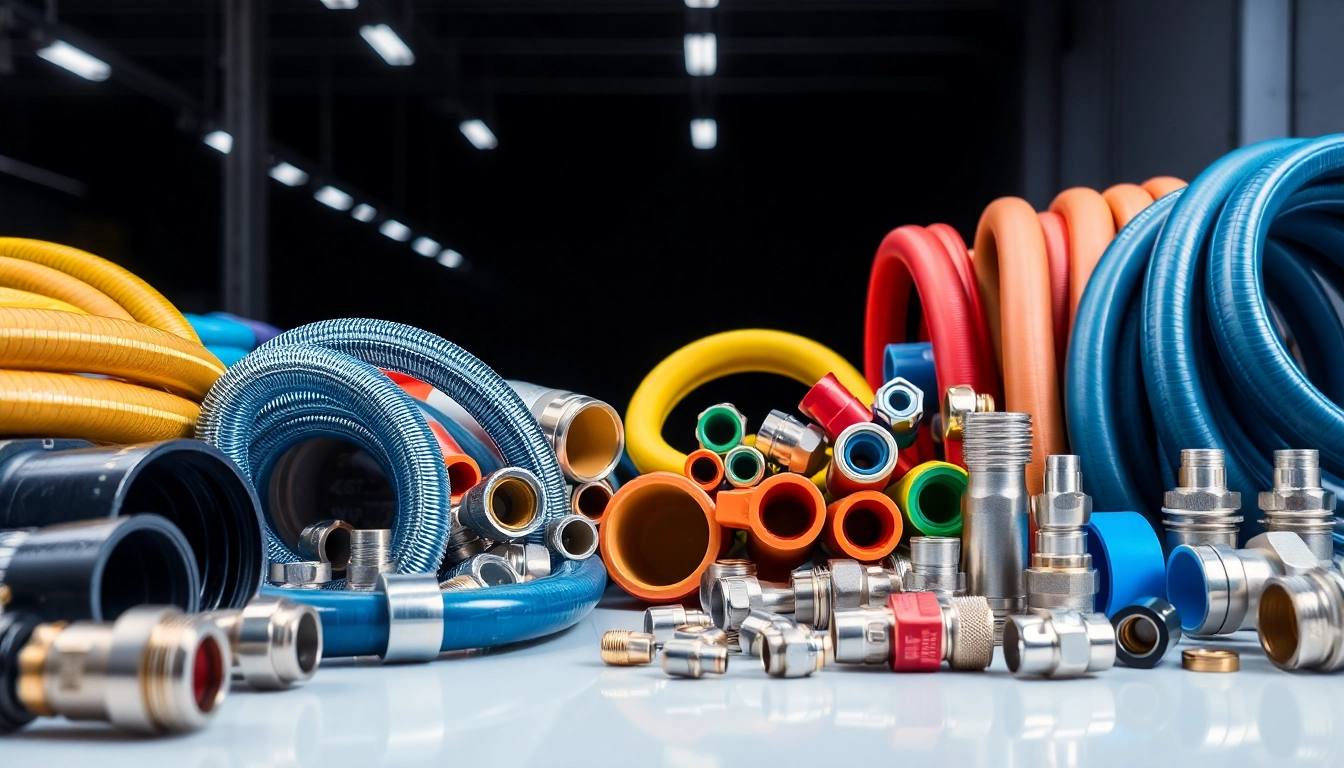Understanding Air Hoses and Fittings
What Are Air Hoses and Fittings?
Air hoses and fittings are critical components in various pneumatic systems, enabling the transfer of compressed air to power tools, machinery, and equipment. Air hoses and fittings act as connectors that allow for quick and efficient movement of air, making them essential in industries ranging from automotive to manufacturing and construction.
Typically made from materials that endure high pressures and different environmental conditions, these components must ensure durability and constant performance. Air hoses offer flexibility and resistance to wear and tear, while fittings determine the compatibility with various tools and their ability to maintain a leak-free connection.
The Importance of Quality in Air Hose Materials
The quality of materials used in manufacturing air hoses and fittings impacts their functionality and lifespan. Materials like rubber, PVC, and polyurethane are important considerations. High-quality rubber hoses, for example, offer excellent flexibility and resistance to abrasion, making them suitable for outdoor use in different weather conditions.
Conversely, PVC hoses are lightweight and often used in indoor applications. Polyurethane hoses provide exceptional flexibility and are often resistant to kinking, but they might not offer the same durability as rubber options. When choosing materials, it’s essential to consider factors such as temperature range, pressure ratings, and specific application requirements.
Types of Air Hoses: A Comprehensive Overview
Air hoses can be categorized based on various standards, including material, diameter, and intended use. The following are common types of air hoses:
- Rubber hoses: Known for their flexibility and durability, suitable for high-pressure applications.
- PVC hoses: Lightweight and cost-effective, best for low-pressure applications.
- Polyurethane hoses: Highly flexible and lightweight, ideal for less abrasive tasks.
- Hybrid hoses: Combine properties of rubber and PVC, providing both flexibility and durability for a variety of conditions.
Understanding the different types ensures that you select the right hose for your application, maximizing efficiency and reducing the risk of failure during operation.
Choosing the Right Air Hose
Factors to Consider for Air Hose Selection
When selecting air hoses, several critical factors should influence your decision:
- Application type: Identify whether the hose will be used outdoors or indoors, in high-pressure environments, or for lighter tasks.
- Length and diameter: Choose a length that corresponds to your workspace’s needs, ensuring that the diameter matches the flow requirements for your tools.
- Pressure rating: Select a hose rated for the maximum pressure your application requires, allowing for a safety margin.
- Flexibility and weight: Consider hoses that are lighter and more flexible where mobility is essential, particularly on job sites.
- Temperature resistance: Ensure the hose can withstand the temperature variations it may encounter in a particular environment.
Common Applications of Air Hoses and Fittings
Air hoses and fittings are utilized in diverse applications across various sectors:
- Automotive workshops: Used for operating tools such as impact wrenches, air ratchets, and paint sprayers.
- Manufacturing: Essential in pneumatic systems, providing power to assembly lines and material handling equipment.
- Construction: Used to operate tools like nail guns and air chisels, which require a constant supply of compressed air.
- HVAC Systems: Used in air conditioning and refrigeration to operate pneumatic components.
These applications emphasize the need for reliability and efficiency in your choice of air hoses and fittings.
How to Measure Hose Size and Compatibility
When it comes to measuring hose size and ensuring compatibility with fittings and tools, proper measurement is critical:
Start by measuring the inner diameter (ID) of the hose using a caliper. It’s also essential to determine the outer diameter (OD) if you’re working with connections that require a snug fit. Additionally, you should be aware of the thread size and compatibility of appliance fittings. A good rule of thumb is to consult the manufacturer’s specifications to confirm that your selected hose matches the fitting fittings of your tools.
Remember that mismatched sizes can lead to leaks or ineffective air supply, ultimately impacting performance.
Air Fittings: Types and Uses
Understanding Different Types of Air Hose Fittings
Air hose fittings come in various types, each designed for specific purposes:
- Quick-connect fittings: Facilitate easy connection and disconnection of hoses without tools.
- Threaded fittings: Suitable for permanent installations and can withstand higher pressures.
- Sockets and plugs: Provide a secure connection between hoses and tools, ensuring that airflow is properly directed.
- Adapters: Allow for connection between different sizes or types of hoses and fittings.
Understanding these types enables users to customize their pneumatic systems to fit specific needs.
How to Choose the Best Fittings for Your Tools
Choosing the appropriate fittings involves understanding both the tool specifications and operational requirements:
- Check tool specifications: Ensure that you adhere to the manufacturer’s recommendations on fitting sizes and pressure ratings.
- Material compatibility: Select fittings made from materials that resist corrosion and wear, especially in demanding environments.
- Evaluate ease of use: Consider fittings that allow for quick connections—important in high-traffic areas where disconnection might happen frequently.
- Consult product reviews: Research fitting configurations that have been tested and recommended by professionals in the field.
Examples of Common Air Fittings in Use
Some common examples of air fittings you might encounter include:
- AN fitting: Used primarily in automotive applications for high-pressure connections.
- Barb fitting: Often found in low-pressure applications, suitable for flexible hoses.
- Compression fitting: Utilized for precise applications where tight seals are essential.
- Push-to-connect fittings: Convenient for quick hose changes and connections without the need for tools.
Maintenance Tips for Air Hoses and Fittings
Best Practices for Storing Air Hoses
Proper storage of air hoses can prolong their life significantly. Consider these best practices:
- Wind hoses neatly: Avoid kinks or twists that can damage the material.
- Store in a cool, dry place: Minimize exposure to sunlight, as UV rays can degrade hoses, particularly those made from rubber or PVC.
- Separate storage for hoses and fittings: To prevent scratches or damage, keep different types of equipment stored apart.
How to Inspect and Maintain Your Fittings
Regular inspection of fittings ensures that your air system runs efficiently. Here are steps to consider:
- Look for wear and tear: Frequent checks can identify signs of corrosion or cracks.
- Clean fittings regularly: Dust and debris can accumulate, affecting the seal. Use a soft cloth to keep them clean.
- Test connections: Ensure that hoses fit securely without leaks, and replace any fittings that show signs of wear.
Troubleshooting Common Issues with Air Hoses
Despite best efforts, issues may still arise. Here are common problems and their solutions:
- Leaking fittings: Often caused by improper installation; check that threads are properly sealed and fittings are tight.
- Kinking or flattening of hoses: Ensure that hoses are not subjected to crushing or twisting during use or storage.
- Poor airflow: This may indicate blockages, commonly caused by dirt or debris; regular maintenance can help mitigate these issues.
Where to Buy Quality Air Hoses and Fittings
Leading Retailers for Air Tools and Accessories
When looking for quality air hoses and fittings, several reputable retailers offer a variety of products:
- Online marketplaces: Sites like Amazon and eBay have extensive selections, including user reviews to aid in decision making.
- Specialty retailers: Companies such as Northern Tool and JACO offer specialized products tailored specifically for air tools.
- Local hardware stores: Often provide knowledgeable staff who can offer recommendations based on specific needs.
Online vs. In-Store Purchases: What You Need to Know
Choosing between online and in-store purchases largely depends on personal preference and specific needs:
- Online shopping: Provides the benefit of detailed product descriptions, user reviews, and the convenience of home delivery.
- In-store shopping: Allows for hands-on examination of products and immediate acquisition without waiting for shipping.
Evaluating Brands and Product Reviews
Before making a purchase, it’s wise to evaluate both the brand and specific product reviews:
- Brand reputation: Consider brands known for quality and customer service, such as Flexzilla or Milton.
- Product reviews: Look for customer feedback regarding durability, ease of use, and application suitability.
- Warranty and support: A good warranty can offer peace of mind and indicate a manufacturer’s confidence in their product.



